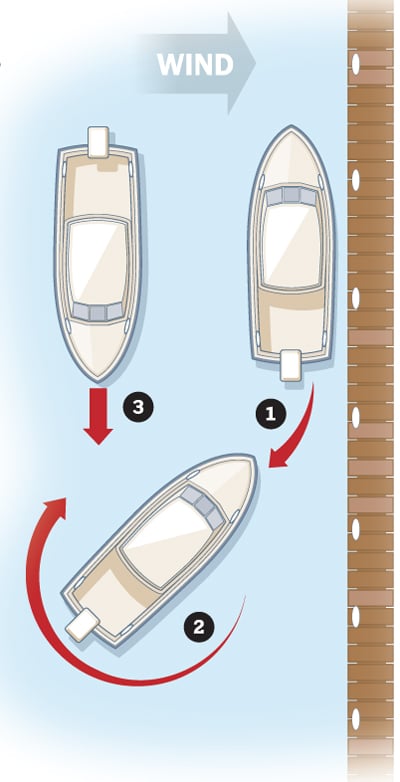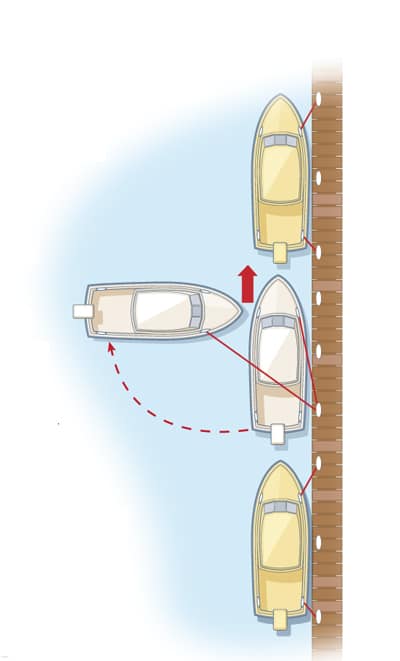There are no hard and fast steps for close-quarters maneuvering. Every boat handles differently, and the number of scenarios is limitless. But there are principles and practices that, if understood for one situation, can be applied with other techniques to get you out of a tough spot with grace. Here are three situations we’ve all encountered.
[1]Full Astern!
Let’s suppose you’re tied side to a fuel deck with an onshore breeze pressing your boat against the bulkhead. Leave this berth using forward gear, and you’ll bump the dock with your stern. You might never get off, as each transom bump straightens the boat’s heading, negating your efforts at the wheel.
Boats steer from the back. You can use this principle to get away with ease in this situation. Put the helm hard over, away from the dock. Then put the engine in reverse. Don’t be shy with the throttle. The stern will move away from the dock, and the bow will follow. You will have made a U-turn going backward that will get you clear without a bump.

[2]Leeward Lines First
Your boat’s tanks full, you decide to visit a friend’s marina so you can regale him with tales of dock-leaving mastery! When it’s time to go, the wind is again on your beam but stronger now. You’re tied bow-on in a slip, your stern lines fixed to pilings aft. The boat to leeward is a gold-plated woody, restored to bottle finish. You don’t even want to think about bumping it. Help yourself out by remembering that a slack line does no work. Instruct your crew to remove the lines on the downward side first, since only the lines to weather are holding your boat in position. Releasing the windward lines, back out without hesitating. Had the windward lines been released first, you’d have banged that woody before you even put the boat in gear.

[3]Tail The Spring
After a few hours’ cruising, you decide to hit a waterfront spot for dinner. You find a stretch of bulkhead and dock side-to. The same onshore breeze is at work, but flush with your successes at backing away you tie up and chow down. After supper you come out to discover that there are boats tied fore and aft of yours, leaving no room for the back-away turn. Don’t fret. Instead, use a spring line, pitting effort against resistance to create a change in direction.
Tie a line to your bow cleat and run it to a dock cleat astern, fixing the other end on the dock somewhere aft of amidships. The farther aft the better. Now ease the boat foward. As the line comes tight, the stern will swing seaward – you can turn the wheel toward the dock to help this along – until you are bow-on to the dock. Release the line and back away This may require some scurrying if you’re alone. With crew aboard, assign someone to “tail” the spring line. That is, instead of hitching the line to the cleat, a crew member takes a couple of turns around its base, tending the line by maintaining pressure until you give the signal to release it.









